 | |||
 | |||
 | |||
WALNUTS
What is the nutritional value of the walnut?
Walnuts provide energy, essential vitamins and minerals. Due to their high fat content they keep one’s hunger at bay for a long time. Their high proportion of unsaturated fatty acids are an especially important factor in many diets; some even claim that they may help reduce blood cholesterol. As far as calories go, walnuts are in the middle range of energy-producing foods.
All in all, walnuts are the American homemaker’s favorite ingredient nut, used in cookies and cakes, pies and confections. Of late, they have become an important component in natural health blends containing dried fruits, coconut, sesame and sunflower seeds.
Where was the walnut first cultivated and where was it subsequently grown?
During Roman times the walnut was cultivated in Europe, ranging from Italy through France. In fact, it is possible that later, when the nut reached England, it was named ‘walnut’ as a corruption of the name ‘Gaul nut’. In England the tree was actually more popular as an ornamental and for its exceptional hard wood, rather than for its nut.
Because the walnut shell and kernel resemble the human skull and brain, it was considered of medicinal benefit to head wounds and even mental illness in medieval Europe. Even though the British climate was unsuitable for cultivating superior walnut varieties from warmer climates, by the end of the 16th century it was definitely familiar in England.
The walnut has been introduced to many temperate climates extending over the Northern Hemisphere, and even a few in Australia and New Zealand, which has resulted in the development of numerous walnut varieties.
What is the world production of walnuts?
The United States leads the world in walnut production, with almost all of the U.S. walnuts growing in California. Turkey, China and the Soviet Union also produce a substantial walnut crop, followed by some other countries whose production is on a smaller scale. About 90% of U.S. exports are in-shell, with the remainder in the form of shelled nuts. Although the U.S. is a leader in walnut exports, it can expect increasing competition from China and India, where the walnut industry is expanding.
What type of walnut grows in the U.S.?
The largest native species of walnut in North America is the eastern black walnut. It is valuable both for its flavorful nut, as well as for its high quality wood. A single black walnut tree is worth $30,000, its wood used in the manufacture of furniture and gun handles.
However, the black walnut harvest of approximately twenty thousand tons is only one- tenth the size of the California Persian walnut harvest. In addition there are four other walnut species native to North America: including the butternut or white walnut, and three minor species which produce very small nuts that are enjoyed mostly by wildlife. The walnut family also includes the pecan and other hickories.
How are walnuts grown in an orchard?
There has to be a spacing of at least 50 feet between mature walnut trees, in order to obtain the biggest yields. It takes 5 to 8 years for a tree to produce a harvestable crop. Young trees are trained to form 5 or 6 main branches, after which they are pruned by thinning out and removing weak and crowded branches. Weeds are controlled, fertilizer applied and dead trees replaced, to maintain maximum capacity of the fields. In California, most fields are irrigated. As far as the useful life of a walnut tree, some estimate that there are trees 50, 75 and even 100 years old that continue to produce excellent nuts!
When is the right time to harvest walnuts?
Since a well-filled walnut shell yields a high kernel percentage it is advisable to learn just when the crop has reached that stage. This may vary with different breeds. One must also be careful not to let the kernel get so tight in the shell that it would be difficult to extract or it would break in the cracking machine. Persian walnuts are mature when the hull can be easily separated from the shell. Usually the hull opens while still attached to the tree, but sometimes the wind brings down the hull together with the nut. In California, the walnut harvest season lasts from early September to late November. When 80% of a tree’s nuts are ready harvesting can begin. Harvesting is accomplished by manual or mechanical shaking of the branches to speed up the nut fall. Nowadays machines have largely replaced manual labor, which is costly. The harvested crop, a mixture of hulled and unhulled nuts, is sorted, hulled and washed as soon as possible. Then it is thoroughly dried by mechanical dehydrators, which have taken over from former sun-drying methods.
How are walnuts processed after harvesting?
After being harvested, walnuts are dried to a moisture content of 8%. This retards the development of mold and permits satisfactory bleaching. Then the nuts are sorted into 3 categories, according to how they will be marketed: in shell, kernels or by products.
Growers are paid more for walnuts that can be sold in the shell, about 30% of California’s crop. These nuts are fumigated in steel tanks to destroy any insects which may be present. Then they are bleached by being washed for two or three minutes in a dilute solution of sodium hypochlorite. This weak bleach does not penetrate the shell at all. Then the walnuts are rinsed and rubbed, dried and sampled to determine their quality, after which they are packaged according to four size specifications: Jumbo, Large, Medium and Baby.
The remaining 70% of the crop is known as “cracking stock”.
First it is graded and separated into 6 sizes in order to obtain the highest possible yield of unbroken kernels. After being cracked, the kernels go through air separators to remove shell and fiber material, then they are sorted into dark and light color batches. The shells and fiber are sent to the oil mill, while the shelled walnuts are packaged for sale. Walnuts are treated with an anti-oxidant to preserve freshness. 2-½ pounds of walnuts produce 1 pound of kernels.
The Diamond Walnut Growers produce over 100 combinations of shelled walnut kernels, in different color grades and various other specifications, for commercial clients such as bakeries, candy and ice cream manufacturers.
Since there may still be some kernel in the shell after the shelling operation, they are recovered and either packed for bulk commercial use, or reduced to a mash for pressing, together with other oil-bearing materials and selected plant residue. After being subjected to tremendous pressure to extract the walnut oil, a cake is formed of the remaining material. The walnut oil is filtered and used in the paint industry, whereas the cake is reduced to a meal which is valuable for dairy feed.
What are the two main types of walnut cultivation?
The walnut tree is cultivated either for its edible nut, or as an ornamental or timber tree. A nut producing tree is recognized by its large and abundant branches, while timber trees have narrow crowns and long, straight trunks. Although the walnut tree can flourish in a wide range of temperatures, it can only produce nuts in warmer climates. Walnut wood is a choice material in the manufacture of fine furniture. To this end it was popular with wealthy Romans of the first century as well as European monarchs of the Middle Ages.
Why is the walnut favored as a superior dessert nut?
The walnut is popular as a tasty snack because it requires neither roasting nor salting to enhance its flavor. In Europe, as well as in China, housewives used to blanch, pulverize and soak walnuts in water to produce walnut milk, a nutritious substitute for dairy milk.
Even the green immature walnut, together with its husk, is edible. In England they were pickled and served as a delicacy, or they were made into a jam. A nut brandy was also made from green young walnuts.
How does the Persian walnut grow?
The Persian walnut, which is the one we are most familiar with, grows to a height of about one hundred feet. It requires deep, well-drained, fertile soil. Each tree produces male and female flowers, and for optimum fertilization it is best for several trees to be situated near each other. The fruits are green and ovoid, occurring in clusters of two or three. The tan-colored walnut is enclosed in a hull which separates easily at maturity. The kernel consists of two identical lobes, united at the apex.
What uses have been found for walnut products?
In southern Europe, especially in France, walnut oil is very popular for cooking, and is a good substitute for olive oil. Walnut meal, the residue of oil expression, is a good thickening agent for numerous dishes. Artists prefer walnut oil because it dries slowly, giving the artist more of an opportunity to blend colors.
In the spring, the walnut tree can be tapped for its rising sweet sap, which is boiled down into a sugar in eastern Asia. Additionally, the walnut has been used as a source of dye, with the green hulls yielding a yellowish color and the mature husks a brownish color.
Walnut roots can be boiled to produce a dark pigment, traditionally used by gypsies and actors to stain their skin a deep brown.
The considerable volume of shells produced by the shelling of walnuts is used as a filler for exterior plywood glue, plastics, hard rubber products, roofing material, bricks, tiles, and toy stuffing. Shells are converted into dust to be used in insecticides and abrasives for cleaning jet aircraft engines. A system has even been developed to make use of energy derived from burning walnut shells, by producing steam that drives a turbine to generate electricity.
What medicinal uses have been found in the past for the walnut?
An infusion of powdered walnut leaves was once used, both internally and externally, to treat swollen glands, shingles and sores. Walnut oil was recommended for colic and to soothe the intestines. The juice of green walnut husks was diluted in warm water to be used as a gargle and to stop diarrhea, whereas a green walnut, boiled in sugar, was believed to relieve constipation. Powdered walnut bark was prescribed to treat ringworm. In West Germany, a tea made from walnut leaves is still given to children to relieve running noses and to alleviate skin problems, such as adolescent acne and eczema.
What is the significance of the Latin name for the walnut Juglans regia L.?
The generic term Juglans is a contraction of the Latin Jovis glans, nut of Jupiter, while regia means ‘royal’. According to Pliny, the walnut had been sent to Greece from Persia ‘by the kings’, and the best quality walnuts were known as ‘Persian and royal’.
There are about 15 species of Juglans, the walnut genus. They belong to the walnut family, the Juglandaceae. Although all walnuts are edible, J. regia, the Persian (or English) walnut is the most delicious and important. Walnuts have been cultivated from selected seed for such a long time, that they have become quite different from their original, wild ancestors.

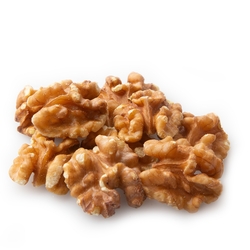



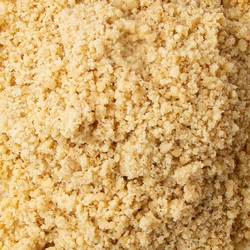
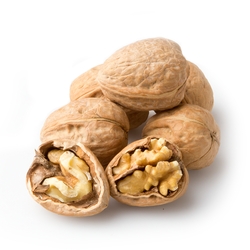
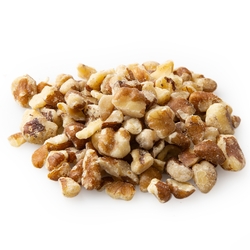
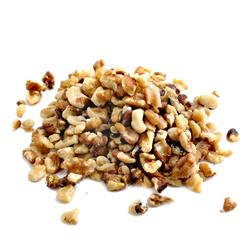
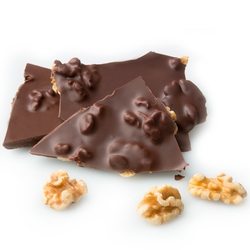
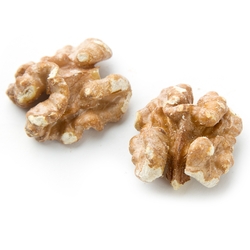
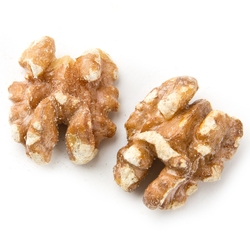
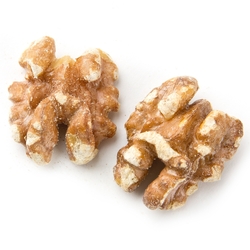
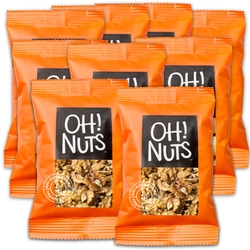
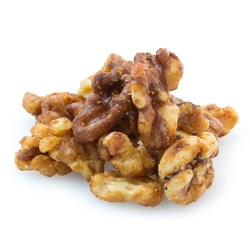
 or
or 
